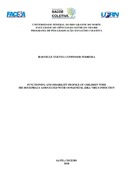Use este identificador para citar ou linkar para este item:
https://repositorio.ufrn.br/handle/123456789/25035| Título: | Functioning and disability profile of children with microcephaly associated with congenital zika virus infection |
| Autor(es): | Ferreira, Haryelle Naryma Confessor |
| Orientador: | Hull, Egmar Longo |
| Palavras-chave: | CIF;Public health;Zika virus infection;Microcephaly;Children |
| Data do documento: | 26-Fev-2018 |
| Referência: | FERREIRA, Haryelle Naryma Confessor. Functioning and disability profile of children with microcephaly associated with congenital zika virus infection. 2018. 26f. Dissertação (Mestrado em Saúde Coletiva) - Faculdade de Ciências da Saúde do Trairi, Universidade Federal do Rio Grande do Norte, Natal, 2018. |
| Resumo: | Introduction: The increase in the number of cases of microcephaly in Brazil and its association with the Zika virus (ZIKV) is a global public health problem. The International Classification of Functioning Disability and Health (ICF) model is a powerful tool and extremely relevant in managing disability. Objective: Describe the functioning profile of children with microcephaly associated with ZIKV in two states of northeastern Brazil. Methods: This is a descriptive cross-sectional study. The sociodemographic characteristics, head circumference and other clinical data were collected from medical charts, physical examinations, measuring instruments and interviews with the children and their parents. The Brazilian Portuguese version of the ICF core set for cerebral palsy (CP) was used. Each ICF category was assigned a qualifier, which ranged from 0 to 4 (no disability, mild disability, moderate disability, severe disability and complete disability). For environmental factors, 0 represents no barrier and 4 total barrier; +0, no facilitator +4, total facilitator. Results: A total of 34 children with microcephaly caused by ZIKV were recruited (18 girls and 16 boys) at four rehabilitation facilities in Rio Grande do Norte and Paraíba states, Brazil. The average age of the participants was 21 months and head circumference z-scores ranged from 0.92 to -5.51. The functioning profile revealed complete disability in most of the body function categories (b). The activity and participation areas (d) were highly impacted, particularly in mobility-related categories. With respect to environmental factors (e), most of the sample reported a total facilitator for the nuclear family, friends and health services, systems and policies, as well as a total barrier to social attitudes. Conclusion: This is the first study that describes the functioning profile of children with microcephaly associated with ZIKV, using a tool based on the ICF in Brazil. Our findings reinforce the need to maximize health care and access to information – based on the ICF – for multiprofessional teams, administrators, family members and children. |
| URI: | https://repositorio.ufrn.br/jspui/handle/123456789/25035 |
| Aparece nas coleções: | PPGSCOL/FACISA - Mestrado em Saúde Coletiva |
Arquivos associados a este item:
| Arquivo | Descrição | Tamanho | Formato | |
|---|---|---|---|---|
| HaryelleNarymaConfessorFerreira_DISSERT.pdf | 884,62 kB | Adobe PDF |  Visualizar/Abrir |
Os itens no repositório estão protegidos por copyright, com todos os direitos reservados, salvo quando é indicado o contrário.

